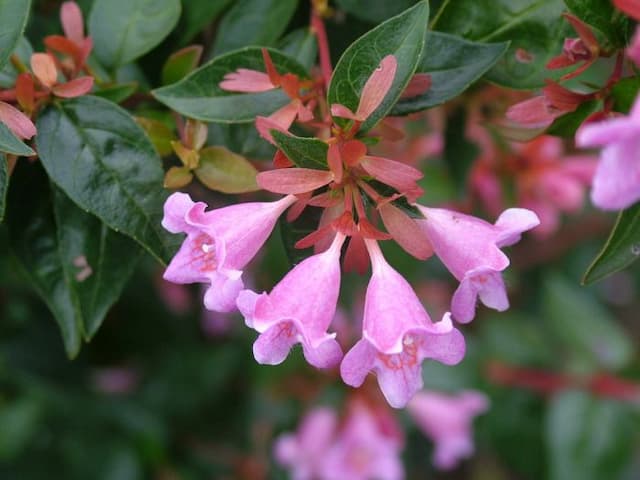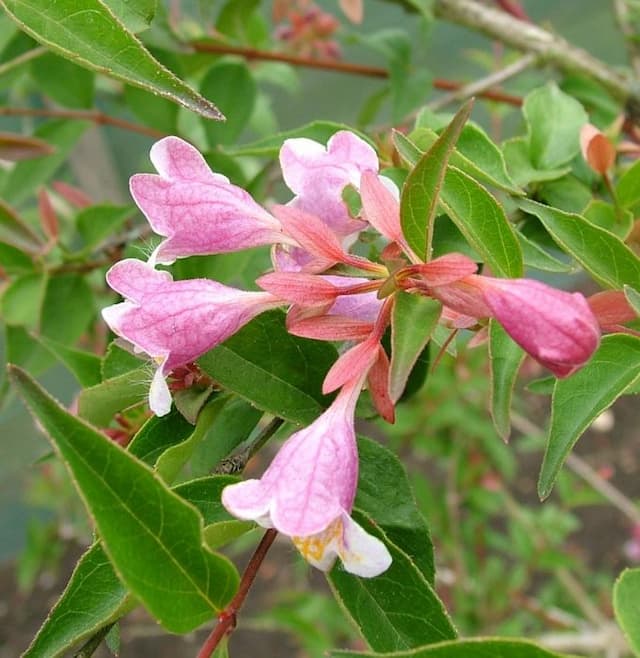Korean Abelia Abelia mosanensis

ABOUT
The plant in question, commonly known as the Korean Abel, spills with beauty and charm throughout its structure. It is a deciduous shrub, which means it sheds its leaves annually. The Korean Abel is characterized by its arching branches that give it an elegant, fountain-like silhouette. These branches are adorned with small, glossy leaves that are typically green but may take on a bronze hue in the fall, contributing to its seasonal appeal. The Korean Abel truly comes into its own in late spring or early summer when it starts to bloom. The flowers are bell-shaped and arranged in clusters, exuding a delightfully sweet and spicy fragrance that can enchant any passerby or pollinator. These blooms boast a pink to white hue and can add a soft and romantic touch to any garden landscape. One of the most striking attributes of the Korean Abel is its ability to attract various pollinators. This plant is a haven for bees, butterflies, and other beneficial insects, thanks to its prolific flowering and enticing aroma. As the seasons change, the foliage may transition in color, providing a visual feast of warm autumnal shades before the leaves eventually fall away. To maintain its attractive appearance, this shrub may be pruned after flowering, encouraging new growth and a more compact, lush form. With these features, the Korean Abel is an alluring addition to any garden that seeks a blend of visual elegance and a beacon for wildlife.
About this plant
 Names
NamesFamily
Caprifoliaceae
Synonyms
Korean Abelia, Fragrant Abelia, Mosan Abelia, Bridal Bouquet
Common names
Abelia mosanensis
 Toxicity
ToxicityTo humans
Korean Abelia is generally not considered toxic to humans. Therefore, ingestion of this plant should not lead to poisoning or cause symptoms of toxicity.
To pets
Korean Abelia is also generally considered non-toxic to pets. It is unlikely that ingestion would result in poisoning or produce adverse symptoms. However, as with any plant material, ingestion in large quantities could potentially cause mild stomach upset due to the fibrous plant matter.
 Characteristics
CharacteristicsLife cycle
Perennials
Foliage type
Deciduous
Color of leaves
Green
Flower color
Pink
Height
4-6 feet (1.2-1.8 meters)
Spread
4-6 feet (1.2-1.8 meters)
Plant type
Shrub
Hardiness zones
5
Native area
Korea
Benefits
 General Benefits
General Benefits- Attractive Flowers: Abelia mosanensis, commonly known as Korean abelia, bears fragrant, bell-shaped flowers that add aesthetic value to gardens.
- Pollinator Friendly: The blooms attract bees, butterflies, and other pollinating insects, supporting biodiversity.
- Four-Season Interest: This plant offers visual interest throughout the year with spring blooms, summer greenery, autumn color change, and even winter interest with its bark.
- Low Maintenance: Korean abelia is relatively easy to care for, requiring minimal pruning and being adaptable to various soil conditions.
- Drought Tolerance: Once established, it is drought-resistant, making it a good choice for gardens in drier climates.
- Hardiness: It is hardy in a variety of climates and can withstand cold temperatures, making it suitable for many gardens.
- Privacy and Border Planting: With its dense growth habit, it can serve as a privacy screen or be used for border planting.
- Erosion Control: The root system helps to stabilize soil and prevent erosion on slopes.
 Medical Properties
Medical PropertiesThis plant is not used for medical purposes.
 Air-purifying Qualities
Air-purifying QualitiesThis plant is not specifically known for air purifying qualities.
 Other Uses
Other Uses- Insect Attraction: Korean Abelia is known to attract a variety of insects, such as bees and butterflies, providing a food source and aiding in pollination within the garden ecosystem.
- Cut Flowers: Due to its fragrant and attractive blooms, Korean Abelia can be used in floral arrangements.
- Wildlife Shelter: The dense growth habit of Korean Abelia provides excellent shelter for small wildlife, such as birds and beneficial insects.
- Photography: With its appealing flowers, Korean Abelia serves as a beautiful subject for garden and nature photography.
- Seasonal Interest: Adding visual interest to the garden, Korean Abelia’s spring flowers and fall foliage provide ornamental value across seasons.
- Natural Fence: When planted in a row, Korean Abelia can form a natural and decorative border or fencing.
- Hedging: Its dense and bushy habit makes Korean Abelia suitable for creating low hedges and garden partitions.
- Educational Tool: Korean Abelia can be used in educational settings, such as schools or botanical gardens, to teach about plant growth, reproduction, and care.
- Urban Landscaping: Due to its manageable size and appealing aesthetic, Korean Abelia is suitable for city parks and urban garden designs.
- Garden Themes: Utilized in themed garden spaces, such as Asian-inspired gardens, due to its origin and charming characteristics.
Interesting Facts
 Feng Shui
Feng ShuiThe plant_name is not used in Feng Shui practice.
 Zodiac Sign Compitability
Zodiac Sign CompitabilityThe plant_name is not used in astrology practice.
 Plant Symbolism
Plant Symbolism- Rebirth: Abelia mosanensis blooms in late spring to early summer, symbolizing new beginnings and the cycle of life.
- Fragrance: The plant is known for its sweet, intense fragrance, often symbolizing allure and sensuality in the language of flowers.
- Adaptability: Able to thrive in various conditions, Abelia mosanensis represents flexibility and the ability to adapt to changing environments.
 Water
WaterKorean Abelia should be watered regularly, particularly during its first growing season to establish a deep and extensive root system. Once established, the plant is quite drought-tolerant, but it is still recommended to water it thoroughly once a week, providing about 1-2 gallons per week, depending on the climate and soil conditions. During periods of extreme heat or dryness, increase watering frequency to prevent stress. It's essential to avoid overwatering, as this can lead to root rot. Water the plant at the base to keep the foliage dry, reducing the risk of disease.
 Light
LightKorean Abelia thrives in full sun to partial shade. The best spot for the plant would provide it with at least 6 hours of direct sunlight daily, while also offering some shelter from the intense afternoon sun in hot climates. An area that receives morning sunlight and dappled shade in the afternoon is ideal, as it balances the plant's need for sunlight with protection during the hottest part of the day.
 Temperature
TemperatureKorean Abelia is hardy and can tolerate a range of temperatures, from as low as 5°F in winter to highs reaching up to 90°F in summer without severe damage. However, the ideal temperature range for this plant is between 60°F and 70°F, where it will grow most vigorously. Extreme temperatures can stress the plant, so consider providing protection or adjusting its care during unusually hot or cold periods.
 Pruning
PruningPrune Korean Abelia after it finishes flowering, typically in late summer or early fall, to maintain its shape and encourage bushier growth. Pruning is also necessary to remove any dead or damaged branches, which will improve the plant's overall health. It's advisable to prune yearly, but the plant can tolerate heavier pruning every 2 to 3 years if needed. The best time for significant thinning cuts is late winter or early spring, just before new growth starts.
 Cleaning
CleaningAs needed
 Soil
SoilThe Korean Abelia requires a well-draining soil mix with a high content of organic matter. A mixture of garden soil, peat, and perlite or coarse sand in equal parts is ideal. Ensure the soil pH is slightly acidic to neutral, roughly between 6.0 and 7.5 for optimal growth.
 Repotting
RepottingKorean Abelia should be repotted every few years to prevent it from becoming root-bound. It is best to repot it in the late winter or early spring, just before the new growth starts.
 Humidity & Misting
Humidity & MistingKorean Abelia thrives in average outdoor humidity levels. While it does not have specific humidity requirements, it benefits from occasional misting if grown in a particularly dry environment.
 Suitable locations
Suitable locationsIndoor
Place Korean Abelia in bright indirect light and ensure good airflow.
Outdoor
Plant in well-draining soil with full to partial sun exposure.
Hardiness zone
4-8 USDA.
 Life cycle
Life cycleAbelia mosanensis, commonly known as Korean Abelia, begins its life cycle as a seed which, under the right conditions, germinates in spring. The seedling grows, developing a root system and foliage, eventually maturing into a bushy shrub with arching branches. Throughout spring and early summer, mature Korean Abelia plants produce fragrant, pinkish-white flowers that attract pollinators and may set seed if properly fertilized. After flowering, the plant sets fruit in the form of small, brownish capsules containing seeds for the next generation. In fall, the foliage may turn to attractive shades of orange and red before dropping, as this deciduous plant prepares for winter dormancy. The shrub overwinters with its woody stems until the warmth of spring stimulates another cycle of growth and flowering.
 Propogation
PropogationPropogation time
Spring to early summer
Propogation: The most popular method of propogation for the Abelia mosanensis, commonly known as the Fragrant Abelia, is through softwood cuttings. This typically happens in late spring or early summer, when new growth is mature enough but has not yet become hard or woody. One cuts a piece of the soft, new growth, typically around 4 to 6 inches (10 to 15 centimeters) long, and removes the lower leaves. The cut end can then be dipped into a rooting hormone powder or solution to encourage root development. The stem is then planted in a mix of moistened potting soil and sand or perlite and covered with a plastic bag or dome to maintain high humidity around the cutting. Roots generally develop within several weeks, after which the new Fragrant Abelia plant can be gradually acclimated to less humid conditions before planting it out in the garden.







![Himalayan honeysuckle [Golden Lanterns]](/_next/image?url=https%3A%2F%2Fplants-admin.emdemapps.com%2Fimages%2Fplants%2F%2Fimages%2F604b55302cc87.png&w=640&q=75)

